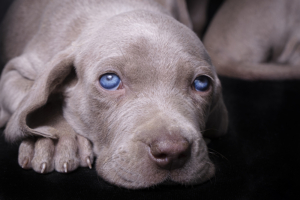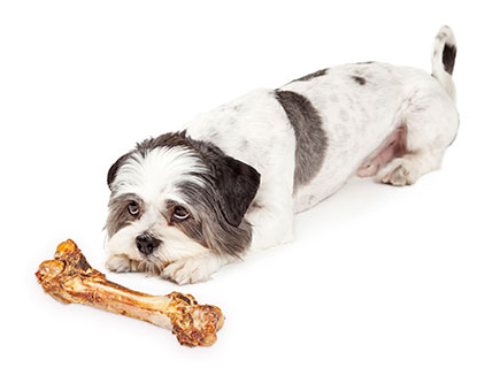
Close-up of a weimaraner puppy with wide open blue eyes.
Inside the eye is a lens that focuses light on the back of the eye or the retina. Vision occurs at the retina. The structure of the eye is like a camera, which has a lens to focus light on the film. Dogs over the age of about 8 years old develop a blue hazy appearance to the lenses of their eyes. This normal change is called sclerosis and does not affect your pet’s vision unless it becomes quite pronounced in the late stages of life. Sclerosis results when the lens hardens and becomes more denser as the dog ages. Cataracts, on the other hand, are the clouding of the lens of the eye which keeps light from passing through. Cataracts can be small or completely cover the lens and vision loss may be lost in varying degrees. Cataracts can occur at any age and some puppies are even born with them. The most common cause of cataracts is inherited but they can also be caused by nutritional deficiencies, poisons, drugs such as cortisone, inflammation, and elevated blood sugar (side effect of diabetes). Hereditary cataracts can affect many breeds of dogs. Breeds that are more susceptible to cataracts include the American Cocker Spaniel, Labrador Retriever, French Poodle, Boston Terrier, and the Welsh Springer Spaniel to name a few. Dogs with diabetes develop cataracts because the high buildup of sugar causes a chemical reaction which eventually clouds the lens tissue in the eye. Some cataracts develop quite rapidly, while others grow very, very slowly. If cataracts occupy less than 30% of the lens or if only one lens is affected, they rarely cause diminished vision. When the opacity covers about 60% of the total lens area, visual impairment often becomes apparent. If the opacity progresses to 100% of the lens, the dog will be blind in the affected eye. However, whether the cataract remains static, or progresses will depend on the type of cataract, the breed and other risk factors. Veterinary ophthalmologists can surgically remove cataracts and restore failing vision caused by cataracts in your pet. Most pets have few complications and return to normal activity, running and playing within just a few days of the surgery. Your veterinarian can arrange a referral appointment to an ophthalmologist to further evaluate your pet’s condition and determine appropriate treatment options. Regular eye exams by your veterinarian will tell you whether there is any cause for concern.





